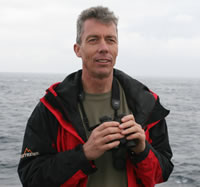
By Peter Ryan, Onboard scientist, expert in general ornithology, seabird-fishery interactions, evolutionary ecology, marine debris, solid waste management, biology of oceanic islands.
Leg 1, Day 3
Although we hoped to wake to Subantarctic waters, we remained in Agulhas waters, with warm-water species again predominating. But at least the ship was able to head across the diminishing swell SSE towards Marion Island, and Southern Ocean taxa* dominated the species list. A regular passage of White-chinned Petrels heading towards Africa made them the most abundant species on transect counts. Despite nearing the end of incubation, they are one of the most vagile of seabirds, and even adults raising small chicks are able to make the long transit to African waters in order to forage.
| White-chinned Petrel* | 74 |
| Great-winged Petrel* | 32 |
| Long-tailed Jaeger | 19 |
| Soft-plumaged Petrel* | 18 |
| Cory’s Shearwater | 15 |
| Northern Giant Petrel* | 4 |
| Sooty Shearwater* | 4 |
| Wilson’s Storm Petrel* | 4 |
| Wandering Albatross* | 3 |
| Shy Albatross* | 2 |
| Indian Yellow-nosed Albatross* | 2 |
| Great Shearwater* | 2 |
| Brown Skua* | 1 |
The rough seas again made it hard to spot cetaceans, and only one unidentified whale (2 distant blows) was seen. No flying fish or squid were seen. The density of drifting debris was less than previous days, with only five items observed in 318 km of transects.
